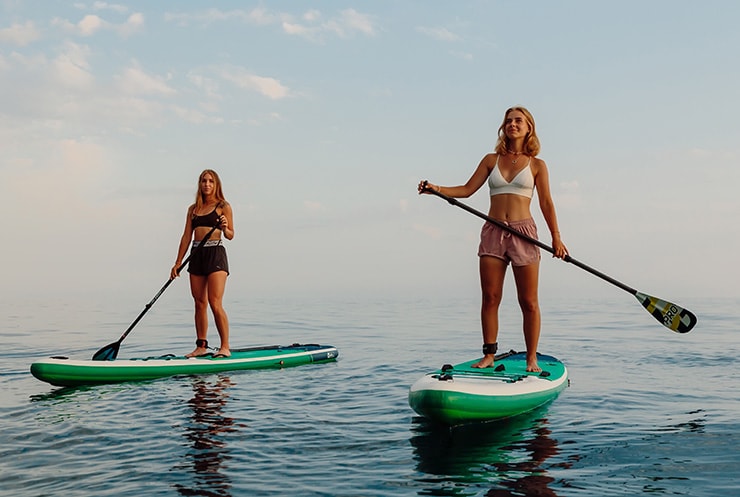Stand up paddle boarding continues to gain traction all around the world. This is not surprising because it’s an amazing sport that everyone can do.
If you’re curious and don’t want to be left behind, you probably have a lot of questions. What exactly is it? How do you get started? What equipment do you need?
Here, I’m going to talk about all things paddle boarding–what it is, its history, what you need to get started, how to paddle safely, and so much more.
If you’re a newbie, it will help you start your new hobby with confidence, with a clear idea of what to get and what to do. And if you’re already a paddler, there’s always room to learn so your experiences can be even better.
Let’s get into it.
Key Takeaways
- Stand up paddle boarding, also known as SUP, is a water sport that involves standing on a large board and propelling oneself forward using a long paddle. Its origins can be traced back to Hawaii in the 1940s.
- Getting started with stand up paddle boarding is easy. You just need the right equipment including a decent board appropriate for your size and skill level, an appropriately sized paddle, and a PFD.
- Once you have the right setup, learning to paddle can be done sequentially – starting by paddling on your knees, learning how to stand up and keep your balance, and practicing paddle strokes.
- SUP is one of the easiest watersports to get into – everyone should give it a try!
So What Exactly is Stand Up Paddle Boarding?
Stand up paddle boarding, also known as SUP, is a paddling sport that involves paddling while standing on a board.
A SUP board looks almost like a surfboard, but it’s bigger. The paddle is single-bladed, meaning that it has a blade only on one end, unlike a kayak paddle.
In 2021 4.5 million paddle boards were sold. In Europe about one in every 20 people owns a paddle board. The paddle board market is estimated to be at $1.5 billion in 2022 and is expected to surpass 3.8 billion by 2032.
This is a clear indication that stand up paddle boarding is not just a passing trend.
But where did it all begin?
The History of Paddle Boarding
In the ancient world, native tribes that lived close to water bodies had vessels that helped them explore the waters and hunt. Some of those vessels were flat platforms, almost like modern-day paddle boards.
The modern version of paddle boarding traces its origins back to Hawaii. It didn’t really begin as a sport, per se.
John Ah Choy, a local Hawaiian surfer, began standing on his board when he got older because his knees started giving him trouble. Getting up and down the board was getting harder. Standing also gave him a better view of his surfing students.
His sons adopted this style and, with time, their friend, Duke Kahanamoku. They are believed to be the inventors of modern-day stand up paddle boarding.
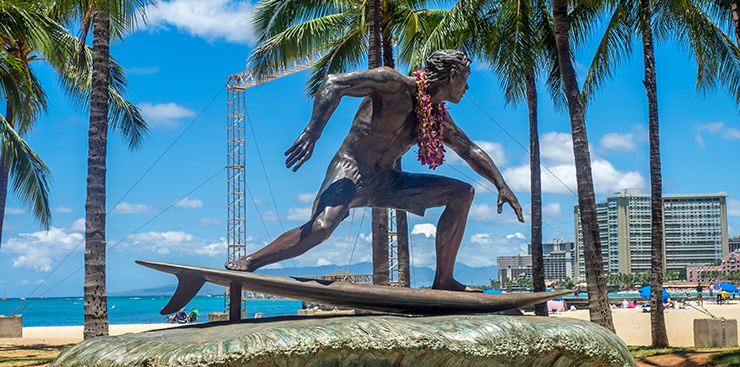
Is Paddle Boarding a Sport?
Yes, paddle boarding is a sport.
Most people get into stand up paddle boarding because it’s a fun and fantastic workout. But competitive SUP is quickly gaining popularity.
There are opportunities for people looking to get into professional SUP–especially in the SUP racing, SUP surfing, and SUP fishing categories.
Unfortunately, paddle boarding is not yet a sport in the Olympics, yet. Hopefully, that will change soon. However, there are tons of other competitions that you can join, both locally and internationally.
It’s not hard to find paddle boarding clubs in your area and those usually hold competitions. Internationally, there are two main bodies that are allowed to hold SUP events: the International Surfing Association and the International Canoe Association.
The ISA began hosting an annual event in 2012, where national teams compete. SUP is the fastest-growing sport in their World Championship series.
The ICF also holds major international events for SUP with various categories.
Important Paddle Boarding Terms to Know
When you’re learning about stand up paddle boarding, you may come across a number of new terms. Like other sports, paddle boarding has its own language too with abbreviations and words that someone on the outside may not understand.
Here are some of the more common ones.
- All-around SUP – a versatile paddle board that can handle most water conditions and SUP disciplines.
- Blade – the wide flat part of your paddle that goes into the water.
- Bungee storage – an elastic cord attached to D-rings on the deck for you to store your belongings.
- Deck – the top part of your paddle board.
- Deck pad – a soft, grippy foam pad that covers a large part of your deck to give you a soft platform for standing on. It also prevents you from slipping.
- D-rings – stainless steel tie-down points on the deck of your SUP board.
- Fin – a small flat accessory at the bottom of a paddle board to help with tracking.
- Gear mounts – attachment points on your paddle board for accessories such as an action camera, fishing rod holder, etc.
- Hull – the bottom part of your paddle board.
- iSUP – acronym for inflatable stand up paddle board.
- Personal flotation device (PFD) – an accessory that you wear to keep you afloat when you fall into the water.
- Shaft – the long straight part of the paddle that connects the blade to the T-bar.
- SUP – this is an acronym for Stand Up Paddle boarding.
- T-bar – the ergonomic handle at the top of the paddle.
- Tracking – the ability of a paddle board to travel in a straight line.
- Tri-fin setup – the most common fin setup for SUP boards. It has two side fins and a larger center fin.
ALSO READ: 76 Stand Up Paddle Board Terms and Their Explanations
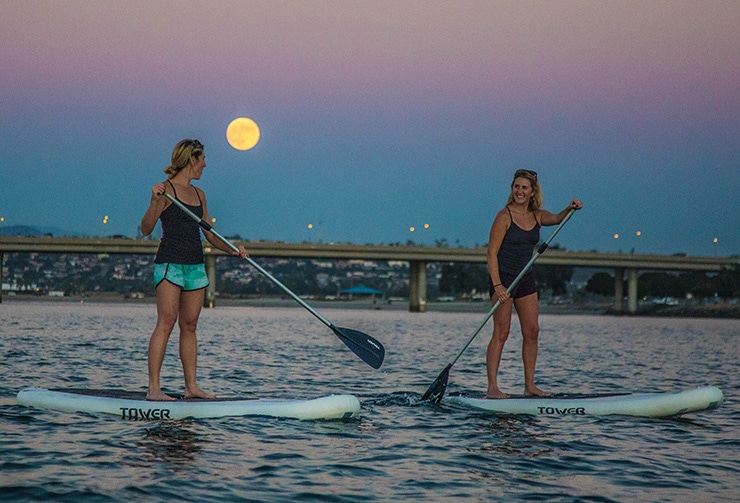
How to Paddle Board: A Quick Start Guide
If you’re new to SUP, the biggest challenge is not knowing where or how to start. But learning how to paddle board is actually easy and fun if you know the basics.
I’m going to share the key essentials you’ll need and important tips to help you get started. This will make your learning process easier and your SUP experiences safer.
1) Ensure You Have The Right SUP Board for Your Needs
The first and most important thing is getting the right paddle board. Stand up paddle boards come in different sizes, shapes, and designs.
You’ll need the right size board and one that’s of good quality.
If you can, stay away from cheap paddle boards. While there are some good cheap ones, it’s easy to end up with one that won’t last.
The size of the paddle board that you should get depends on your size, your lifestyle, and the type of paddling you intend to do.
Beginner paddle boards are generally wider for stability. The wider a SUP board is, the more stable it will be. I recommend a board that’s at least 32 inches wide. You should also note that the wider your paddle board is, the slower it’s likely to be. So make sure you don’t get a board that’s too wide because you’ll be sacrificing performance.
The board should also be of a moderate length so it balances performance and maneuverability. Shorter paddle boards are easier to control but they won’t track as well as longer ones. A length of 10’6 to around 11’6 is great for beginners.
Most beginners do flat water paddling because it’s safer and easier so you can get an all-around board. But there are touring boards for paddling expeditions, race boards for SUP races, whitewater boards for running rivers, and surfing SUPs if you want to catch waves.
I usually recommend inflatable paddle boards over hard boards for newbies. I’ll explain why.
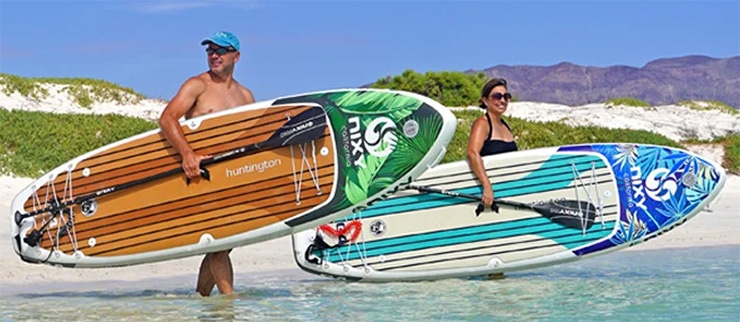
Inflatable Paddle Boards vs Solid Paddle Boards
Both inflatable SUPs and hard SUPs have their pros and cons. But for beginners, I’d say that inflatable boards are better than hard boards.
First, inflatables are generally cheaper, with some of them costing as low as $200. You have a better chance of finding a decent cheap iSUP than a solid one. Even with $450 you can get a quality inflatable paddle board with a good warranty. You’ll need almost double that amount to find a decent solid paddle board.
Besides, in addition to costing less, most inflatables come as a complete SUP package with everything you need to get started. They come with a SUP paddle, leash, SUP bag, and pump. You’ll be lucky to find an affordable hard board that comes with a decent paddle if any.
Another reason why I recommend iSUPs is because they are more durable. They’re made using quality materials and they don’t get easily dented.
Lastly, inflatables are easier to store and transport. They don’t require roof racks or large storage space because they can be deflated and folded to make them smaller.
Hard boards aren’t all bad. Their biggest advantage is performance. They make the best racing and surfing paddle boards.
ALSO READ: Why Are Paddle Boards So Expensive?
2) Start By Paddling on Your Knees
Once you have the right paddle board, paddle, leash, and PFD, it’s time to practice the actual paddling.
When learning how to paddle board, you should stick to calm water, close to shore. You should also make sure that there are people around in case you need help.
Put on your leash and PFD before entering the water. Carry your SUP out into the water, where it’s deep enough that the fins won’t dig into the bottom when you get on the board.
Steady the paddle board by placing your hands on either side, then carefully climb onto the board on your knees. Balancing on a paddle board takes some practice. Starting out on your knees is easier and it helps you get used to being on a small floating platform on the water.
Find your balance, look to the horizon, and start paddling.
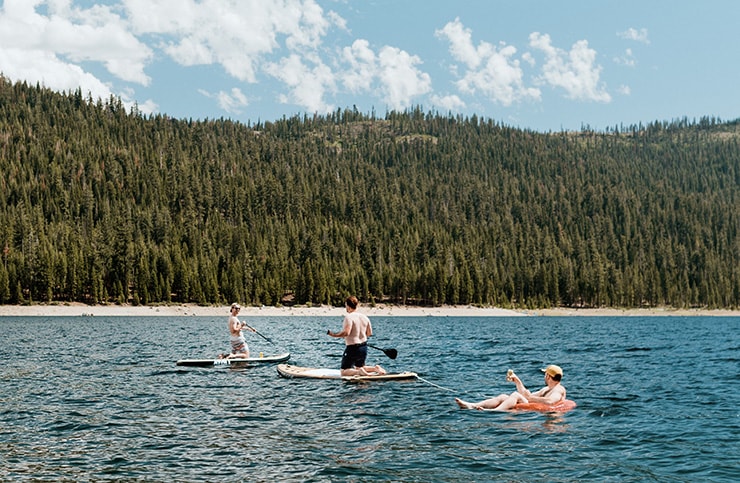
3 Learn How to Balance Properly
After you become confident on your knees you should try standing.
Hold the paddle board on either side to steady it, then slowly bring one foot and place it on the SUP, followed by the other one. Place your feet such that each foot is on either side of the center carry handle, shoulder-width apart. Keep your knees slightly bent.
As soon as you stand, look forward and start paddling immediately. Don’t look at your feet, board, or paddle as you’ll lose your balance. Find a fixed object on the horizon and focus on it – this will help you to keep your balance and paddle in a straight line.
4) Practice the Proper Paddling Technique
The key to paddling properly is to first have the right size paddle and then learn how to hold it. If your paddle is adjustable, hold it straight, parallel to your body. Place one hand on the handle at the top then adjust the height until you can comfortably rest your palm on the handle. That’s the correct height.
To hold it properly, place the paddle on your head perpendicular to your body. Hold the shaft with one hand and the handle with the other. Adjust your hand positions until both elbows are at a 90-degree angle.
The next step is learning the actual paddling. While holding your paddle, reach far forward on one side of the board and plant the paddle blade fully in the water. Keep the blade close to the SUP rail and as vertical as possible.
Your arms should be straight and twist your abdomen slightly towards the side you’re paddling on. Push back the blade and remove it from the water once it reaches your feet. Reach forward and begin another paddle stroke. Switch sides after every few strokes so your SUP board can go in a straight line.
This is the forward stroke for propelling oneself forward. There’s the reverse stroke, which is the opposite of the forward stroke. You do exactly what you do with the forward stroke but in reverse. You can use this stroke to change direction or stop your paddle board.
5) Learn How to Fall off and Get Back on your Board
When learning how to paddle board, there’s one thing you can be sure of: you’ll fall. It’s all part of the experience and even advanced paddlers fall off their SUP boards from time to time. But you need to learn how to do it properly and safely.
First, you should always aim to fall away from your paddle board. If you hit your paddle board as you fall you might get hurt, especially a solid board. Falling into the water won’t hurt as long as you don’t hit something hard at the bottom.
When you feel yourself losing balance, fall willingly instead of fighting it so you can control where you land. This is a fun way of falling and a much safer one too.
Getting back onto your board isn’t hard and you can learn how to do it in a few tries. Swim to the side of the SUP board. Grab the center carry handle with one hand and push your upper body onto the board, then the rest of the body.
If you have to choose, always swim to your paddle board first and not your paddle. You can use your board to get to your paddle but you can’t use your paddle to get to your board. Besides, if you lose your paddle you can lie on your board and paddle with your arms back to land.
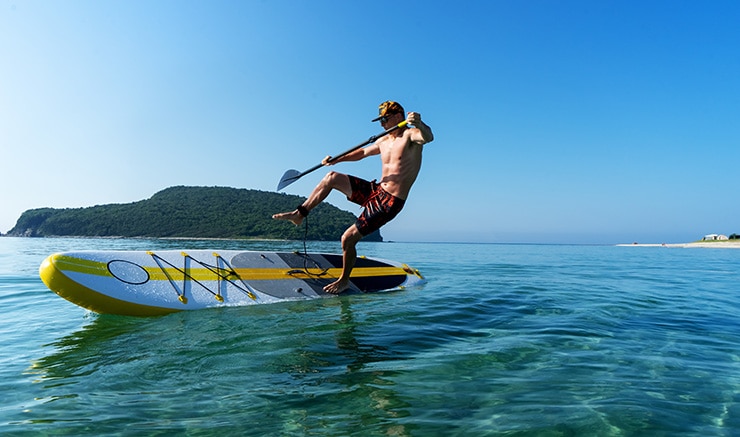
Paddle Boarding Safety Tips
Stand up paddle boarding is a much safer activity compared to many other sports. It’s not easy to get hurt. However, there are still risks, especially because it’s a water sport.
Most of the dangers associated with SUP (there aren’t many) can be avoided by following safety precautions.
Always Wear the Appropriate Gear
There are three things you must never go paddle boarding without; a PFD, leash, and sun protection.
A life jacket or personal floatation device keeps you from drowning when you fall into the water. Every paddler should wear one at all times regardless of their skill level. It’s good to be prepared because you never know what could happen.
It’s also important to ensure that your PFD is working properly, especially if it’s an inflatable one.
A leash keeps you attached to your paddle board so it doesn’t float away when you fall. If you lose your SUP board, you won’t have a floating platform that you can use to get back to safety.
Sun protection is a must because the sun can cause serious damage, both in the short and long term. Wear your sunscreen and reapply it if you jump in for a quick swim. You could also get polarized sunglasses to protect you from glare and a sun hat for extra protection.
Always Check the Weather (Be Prepared!)
I cannot emphasize this enough. Check the weather and water conditions every time before you go paddling. You have to know what you’ll be dealing with.
Check the wind speed and direction, water and air temperature, currents, and tides. If you’ll be paddling in a river you need to check the river level too.
Only go out if the conditions are ideal for SUP.
I always say that it’s better to paddle into the wind (against the wind direction) when paddling out. When paddling back to shore you’ll be paddling in the direction of the wind. This is because paddling against the wind requires more effort due to the resistance. And when you’re paddling back you’ll be tired already.
Learn how to paddle into the wind so you know what to do if the situation changes.
As far as the wind speed goes, if it’s above 12 knots beginners should stay away from the water.
Know Your Limits and Use Common Sense
Many people overestimate their skill level and what they can handle. It’s better to err on the side of caution.
For instance, if you notice the wind is picking up or changing direction, start paddling to shore. Don’t wait until it’s out of control.
If you’re a newbie, avoid paddling too far out into the open ocean on your own or paddling fast rivers. These situations raise the risks and they are better left to skilled paddle boarders.
Be extra careful if you’re pregnant because you may not be able to handle what you could before. Avoid extremely risky paddle boarding disciplines like whitewater SUP.
The same goes for those who can’t swim. While you can still paddle board, you may want to stay on calm, shallow waters until you can handle the water.
Lastly, always use common sense while out on the water. If there have been recent shark sightings, for example, it’s best to stay away. Also, learn to respect wild animals when paddling. Don’t go looking for trouble with sharks, alligators, snakes, and other animals. Keep your distance and paddle back to safety if you see a dangerous animal.
Maintain your Paddle Board Properly
Stand up paddle boards are low-maintenance.
A well-maintained paddle board is more likely to last longer and serve you better. Rinse your paddle board with fresh water after every SUP session, especially after paddling in saltwater. If it has tough stains use a mild detergent and soft cloth then rinse it properly.
Remember to clean the vent plug if you have a solid paddle board or the air valve if you have an iSUP.
Let your paddle board dry completely before you store it.
Inflatable paddle boards can get small punctures sometimes. Check yours regularly, more so if you paddle in rocky areas, and repair any punctures before they get worse.
Bring the Right Paddle Boarding Equipment With You
Other than your paddle boards, there are a few other things that you need to have a fun and safe experience.
You’ll need a paddle, and it should be the correct length. I have explained above how to adjust your paddle to the proper height. Paddles are made using different materials. The cheapest is aluminum but it’s also the heaviest. Fiberglass paddles are lighter and more efficient but more expensive. Carbon paddles are the best and most expensive.
If you have an inflatable SUP, you may need to carry a pump, especially for multi-day paddling trips. Bring the right pump for your board and, if you can, get a SUP electric pump. Inflating a SUP manually can be a real workout.
Don’t forget to bring a repair kit for your iSUP. Most inflatable boards come with one in the package already.
I also recommend getting a dry bag for your clothes and other valuables that you don’t want to get wet. If you’ll be using your phone you might want to get a waterproof phone case so you don’t have to worry about it getting damaged by water.
Carry a lot of fresh drinking water because it’s easy to get dehydrated when paddling. Bring snacks too to replenish your energy.
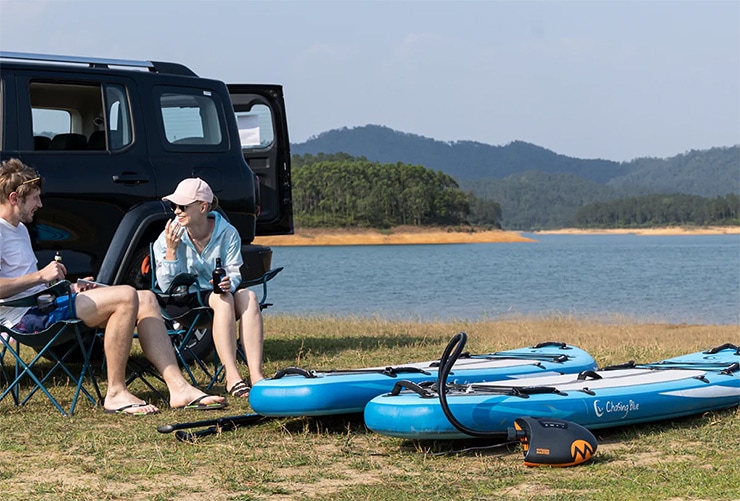
Why You Should Try Stand Up Paddle Boarding
Stand up paddling is a wonderful watersport with some amazing benefits. Here is why I recommend you give it a try.
SUP Is One of the Easiest Watersports to Get Into
One of the best things about SUP is how easy it is to get started.
Paddle boarding is not hard and you don’t need a lot of expensive equipment to start. You also don’t have to live near the ocean or a large lake. With an affordable iSUP package and a PFD, you can hit the water and have fun!
SUP is one of the easiest water sports to learn–it’s much easier than surfing. You can start slowly and paddle while seated or kneeling on calm water until you’re comfortable enough to stand.
I’d also say that SUP is easier than kayaking, even though it doesn’t look like it. Kayaking may be easy but there are some advanced skills like Eskimo rolling that may take a while to learn.
Anyone Can Paddle Board
Paddle boarding is a sport for people of all ages and fitness levels.
Some activities may be impossible or hard to do for bigger people, but not SUP. Paddle boarding doesn’t have a weight limit, although paddle boards do. You can always find a SUP that’s big enough to support you regardless of your weight.
It’s also a customizable sport and you can start slowly as you build your fitness.
SUP is also great for older people and athletes with injuries as it’s gentle and not weight-bearing like running.
Inflatable Paddle Boards are Durable and Practical
Inflatable paddle boards make SUP even more accessible and enticing. They are affordable but super durable. Quality iSUPs are virtually indestructible and they don’t dent as easily as solid boards.
With an inflatable paddle board, you don’t have to worry about storage and transport. It’s great for people living in small apartments and those with smaller cars. Once deflated, an iSUP can fit pretty much anywhere, even under the bed.
Inflatables are also easy to repair and you can do it on your own.
Paddle Boarding Works Multiple Muscle Groups at Once
Another major benefit of paddle boarding is that it’s a full-body workout. Most activities like kayaking usually work a specific set of muscles. While paddling a kayak, your upper body does most of the work while the muscles in your lower body don’t do much.
But paddle boarding works almost every muscle group in your body. Even the smaller muscles you barely use in your daily life will be engaged.
It works your neck, back, chest, arm, shoulder, core, glutes, and leg muscles. Just make sure you’re paddling properly in order to use all these muscles.
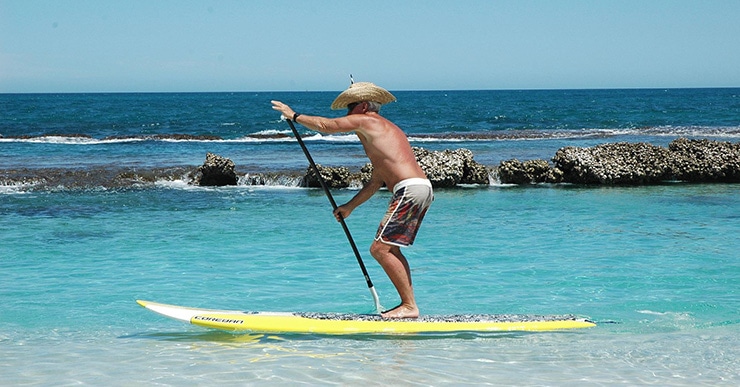
Inflatable Paddle Boards Are a Great Investment
An iSUP is one thing you’ll never regret buying.
Inflatable boards are worth the money because, as mentioned, they are durable. They also come as a complete package with everything you need, including a bag for your board and other paddling essentials.
If you buy a quality inflatable SUP you’ll be using it for a mighty long time. What’s better is that they are portable and you can travel with yours all over the world.
Unlike hard paddle boards, inflatables don’t cost much and you can get a decent board at a low price.
You Can paddle Board With Your Kids, and Even Your Dog
Sometimes doing something with your loved ones makes it much more fun.
If you need company you can bring your child or dog with you as SUP is safe and fun for everyone. Paddle boards have a soft deck pad that is dog- and child-friendly. Your little one or furry friend will have a comfortable surface to stand and sit on for hours.
Paddle boards don’t have an enclosed cockpit. Most dogs love the water but they may not like being enclosed. The open deck on a SUP allows them to be free to jump in for a swim and you also won’t have trouble helping them onto the board.
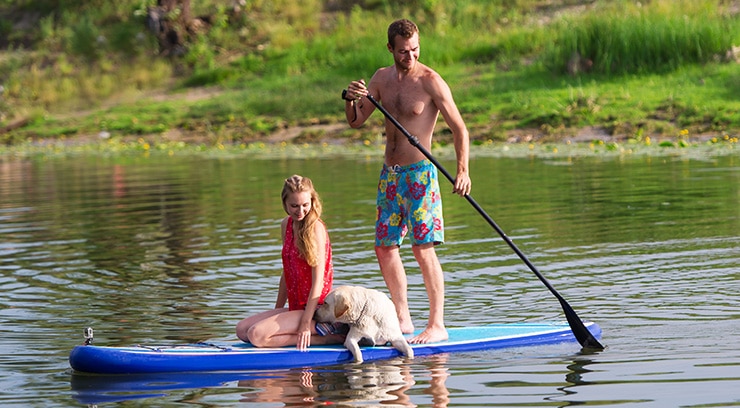
Paddle Boarding Burns a Lot of Calories!
SUP looks simple but it burns more calories than some of the more common activities. You can burn 400 calories in just an hour of relaxed paddling on calm water. These are more calories than you burn cycling, walking or dancing.
You can burn more calories by doing intense paddle boarding activities. For instance, you can burn around 1000 calories in just one hour of SUP racing and 700 calories in an hour of SUP surfing.
Paddle Boarding is Good for Weight Loss
You lose weight by creating a calorie deficit by either burning more than you consume or eating less than your body needs.
You’ve seen above that paddle boarding is highly effective when it comes to burning calories. It can help you lose weight and achieve your fitness goals. And you don’t even need to paddle vigorously.
By burning 500 more calories than you consume each day, you’ll have created a calorie deficit of 3500 by the end of the week. That equals one pound lost. So all you have to do is paddle consistently and eat healthier meals.
SUP is a Versatile Sport (You Can Even Do Yoga on a Paddle Board)
Lastly, SUP is anything but boring. You can customize it to suit your needs and make it as hard or as easy as you want.
You can create a serious SUP training routine to prepare you for SUP races or other competitions.
You can also make it easier and more relaxed by adding an activity like SUP yoga to your routine to improve your flexibility.
Speaking of…
What is SUP Yoga?
Stand up paddle boarding is a combination of SUP and yoga. Instead of practicing yoga in the studio, you take your paddle board and do it on the water. The stand up paddle board acts as your yoga mat.
Doing yoga on a paddle board adds a little challenge to your routine and makes it more fun. A SUP on the water is not as stable as solid ground and this builds your core strength and improves your flexibility.
Paddle boarding yoga has become popular and it’s not hard to see why. SUP yoga retreats are now popping up all around the world to help people get away and enjoy all that SUP yoga has to offer. Going on a retreat like this is a fantastic way to unwind, exercise, and find mental stability.
You can do pretty much any yoga pose on a paddle board. But some will be more challenging than others depending on your experience level. Child’s pose, downward-facing dog, cobra pose, and warrior pose are some simple yoga poses that beginners can start with.
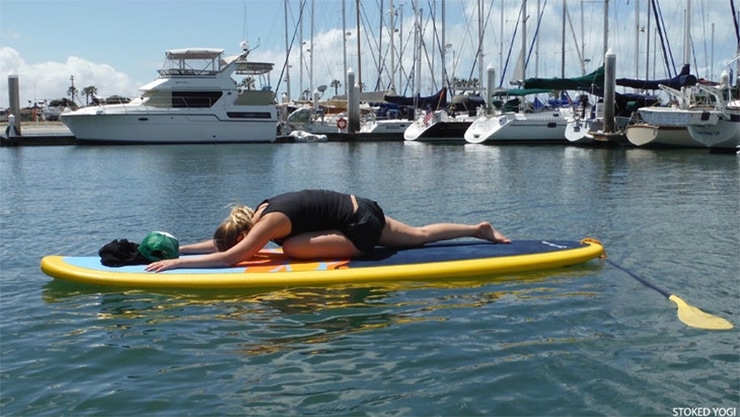
How to Learn SUP Yoga
Paddle board yoga is super easy to learn and you can begin on your own or join a class. Most SUP instructors offer a SUP yoga class as well.
The great thing about doing yoga on a SUP is that you don’t necessarily have to go to the ocean or lake. You can start practicing your poses in a pool. It’s more stable and safer for beginners.
How Difficult is SUP Yoga?
The idea of doing yoga on a SUP on water may sound a little scary.
But paddle board yoga is not hard to learn. You don’t even need to be a pro yogi to get started. Besides, you can start slow and build your balance and flexibility. As long as you can balance on a SUP, the rest will come easy. Start with simple poses and work your way from there.
As a beginner SUP yogi, there are some basic strengths that you’ll want to have. The first one is a good sense of balance because yoga and SUP are both all about balance. It also helps to have decent core strength for paddling and yoga poses.
What Gear Do You Need for SUP Yoga?
The first thing that you’ll need is a good yoga paddle board. There are several different SUP disciplines and for each one, there is a specific paddle board design. A yoga paddle board is one designed specifically for paddle board yoga.
The best yoga paddle boards are wide, no less than 32 inches wide, because width translates to stability. They are also not very short, usually 10 to 11 feet long, because you need a large platform.
Other than a SUP board, you’ll need a paddle to help you get to your SUP yoga destination. You’ll also need to wear appropriate clothing for your yoga sessions on the water. There’s no strict dress code or anything. Just make sure your outfit is weather-appropriate and comfortable. It should be quick-drying too because you can expect to get wet.
Final Thoughts
Stand up paddle boarding is a paddling sport that involves standing on a flat platform–a paddle board. It may be relatively new but it’s one of the fastest-growing sports and the SUP board market is on a steady rise.
SUP originated in Hawaii and it has gone on to become more than just a casual sport. There are now opportunities for people who want to paddle board professionally.
To get started with SUP you’ll need a paddle board, paddle, life jacket, and a leash. Those are the basic accessories. Inflatable boards are a great investment because they are affordable and durable.
The benefits of SUP are many as it’s a full-body workout and it improves your mental health. The best thing about it is that you can make it as hard or as easy as you like. Everybody can do it too!

